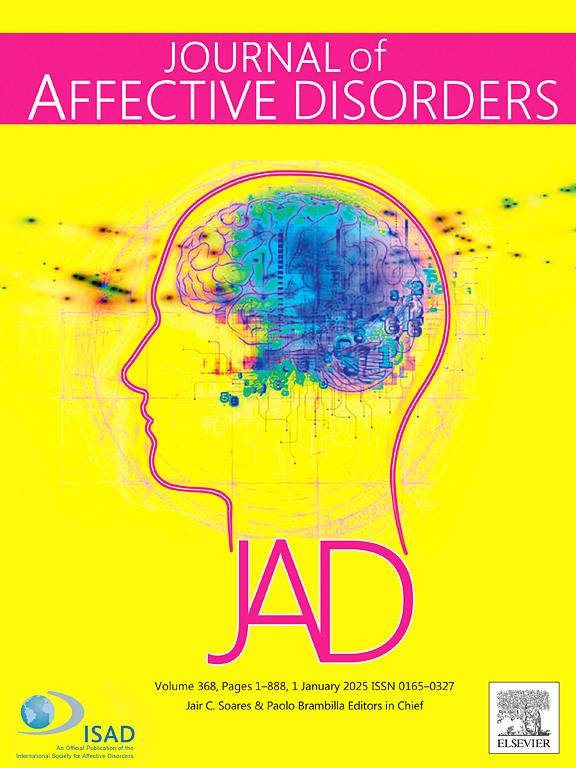重度抑郁障碍(MDD)、创伤后应激障碍(PTSD)、焦虑障碍与过早死亡的因果关系和中介关系:来自全基因组关联研究的证据
IF 4.9
2区 医学
Q1 CLINICAL NEUROLOGY
引用次数: 0
摘要
背景:观察性研究报道,重度抑郁症(MDD)、创伤后应激障碍(PTSD)和焦虑症患者的衰老相关疾病和过早死亡率明显高于普通人群。然而,以往的研究并没有系统地评估MDD、PTSD和焦虑症与过早死亡(衰老和寿命)在遗传水平上可能存在的因果关系,也没有寻找它们之间可能存在的中介。方法:MDD (N = 480,359)、PTSD (N = 206,655)和焦虑症(N = 31,060)的汇总级GWAS数据均来自精神病学基因组学联盟(PGC)。过早死亡的GWAS数据来自两个不同的来源,以对结果进行独立验证:衰老(mvAge, N = 1,958,774)来自Zenodo和人类寿命(N = 1,012,240)来自爱丁堡数据共享。潜在介质的概要级GWAS数据来自FinnGen和UK Biobank数据库。我们首先利用两样本孟德尔随机化(MR)分析来评估重度抑郁症、创伤后应激障碍、焦虑症与年龄(mvAge)和寿命的因果关系。随后,进行中介MR分析,寻找潜在的中介因素。然后,我们采用连锁不平衡评分回归(LDSC)来进一步估计这些遗传相关性基于初始MR结果。最后,进行了一系列的中介MR分析,以更好地了解MDD与寿命之间的关系。结果:我们发现MDD与mvAge和寿命在两样本MR分析中呈负相关,两个GWAS数据库的结果一致,代表过早死亡(mvAge: β (95%CI): -0.064(-0.087-0.041), p g (95%CI): -0.421(-0.479-0.364), p g (95%CI): -0.175 (- 0.237 -0.116), p 结论:我们的综合研究结果提供了强有力的遗传证据,表明MDD患者的过早死亡风险显着增加。这种风险的增加与冠状动脉粥样硬化、高血压和主要冠心病事件的易感性密切相关,这反过来又进一步加剧了他们加速衰老的倾向。本文章由计算机程序翻译,如有差异,请以英文原文为准。
The causal and mediated relationships between major depressive disorder (MDD), post-traumatic stress disorder (PTSD), anxiety disorders and premature mortality: Evidence from genome-wide association study
Background
Observational studies have reported that patients with major depressive disorder (MDD), post-traumatic stress disorder (PTSD), and anxiety disorders have significantly higher rates of aging-related illnesses and premature mortality than the general population. However, previous studies have not systematically assessed the possible causal relationship between MDD, PTSD, and anxiety disorders and premature mortality (aging and lifespan) at the genetic level, or searched for possible mediators between them.
Methods
Summary-level GWAS data for MDD (N = 480,359), PTSD (N = 206,655), and anxiety disorders (N = 31,060) were all obtained from the Psychiatric Genomics Consortium (PGC). The GWAS data for premature mortality were obtained from two different sources for the verification of the results: with aging (mvAge, N = 1,958,774) from Zenodo and human lifespan (N = 1,012,240) from Edinbugh DataShare. The summary-level GWAS data of potential mediators were obtained from FinnGen and UK Biobank databases. We first utilized two-sample Mendelian randomization (MR) analysis to evaluate the causal relationship between MDD, PTSD, anxiety disorders and both aging (mvAge) and lifespan. Subsequently, mediation MR analysis was conducted to search for potential mediating factors. Then, we employed linkage disequilibrium score regression (LDSC) to further estimate these genetic correlations based on the initial MR results. Finally, a series of mediation MR analyses were conducted to better understand the relationship between MDD and lifespan.
Results
We found that MDD was negatively associated with both mvAge and lifespan in two-sample MR analysis, with consistent results across the two GWAS databases representing premature mortality (mvAge: β (95%CI): −0.064(−0.087–0.041), p < 0.001; human lifespan: β (95%CI): −0.081 (−0.138–0.024), p = 0.005). The causal relationship remained significant after false discovery rate (FDR) correction. The results of LDSC suggested a genetic correlation between MDD, mvAge and lifespan (mvAge: rg (95%CI): −0.421(−0.479–0.364), p < 0.001; lifespan: rg (95%CI): −0.175 (−0.238–0.116), p < 0.001). In mediation MR analysis, we found that coronary atherosclerosis, hypertension and major coronary heart disease events were mediators between MDD and lifespan.
Conclusion
Our comprehensive findings provide robust genetic evidence that individuals with MDD are at significantly increased risk of premature mortality. This heightened risk is closely associated with a greater susceptibility to coronary atherosclerosis, hypertension, and major coronary heart disease events, which in turn further accentuate their propensity for accelerated aging.
求助全文
通过发布文献求助,成功后即可免费获取论文全文。
去求助
来源期刊

Journal of affective disorders
医学-精神病学
CiteScore
10.90
自引率
6.10%
发文量
1319
审稿时长
9.3 weeks
期刊介绍:
The Journal of Affective Disorders publishes papers concerned with affective disorders in the widest sense: depression, mania, mood spectrum, emotions and personality, anxiety and stress. It is interdisciplinary and aims to bring together different approaches for a diverse readership. Top quality papers will be accepted dealing with any aspect of affective disorders, including neuroimaging, cognitive neurosciences, genetics, molecular biology, experimental and clinical neurosciences, pharmacology, neuroimmunoendocrinology, intervention and treatment trials.
 求助内容:
求助内容: 应助结果提醒方式:
应助结果提醒方式:


